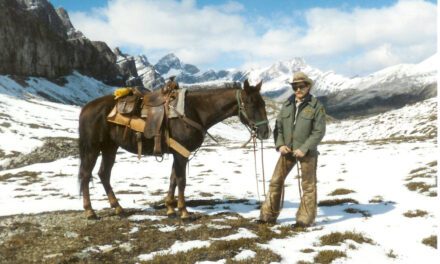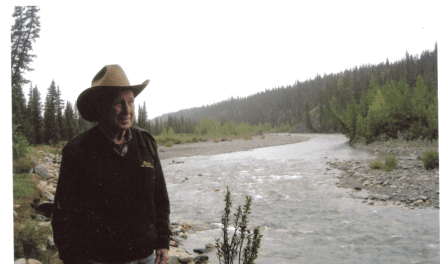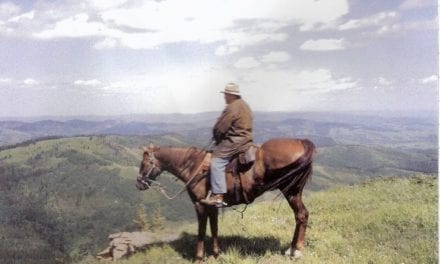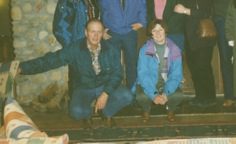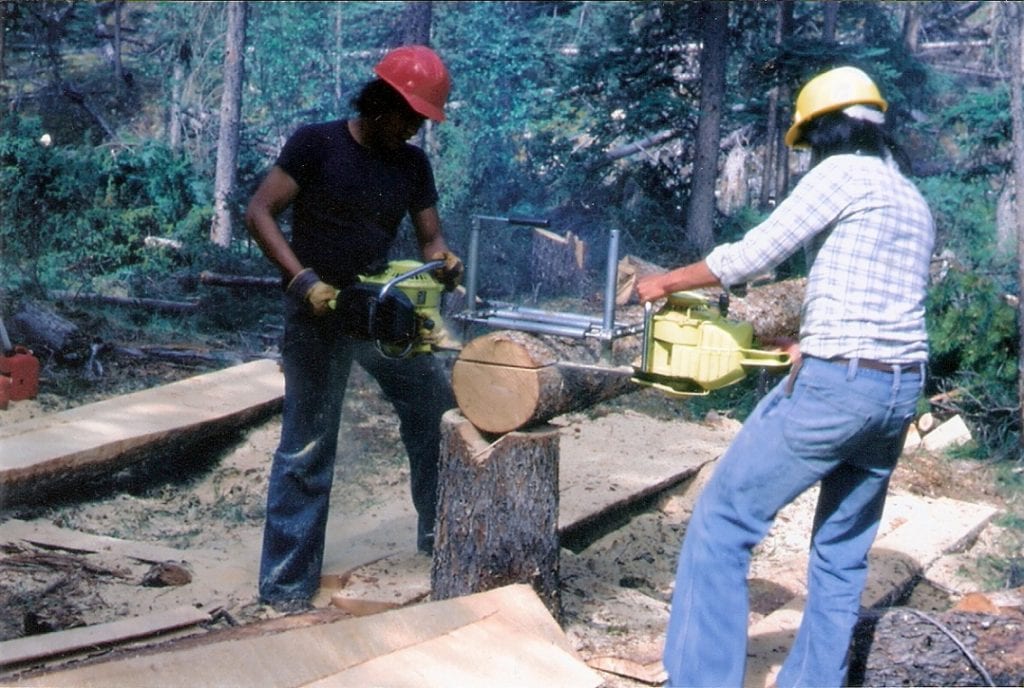
Native Trail Crew Jasper National Park
(6:34) We also had a flying trail crew we called it. It was a small crew that we flew into hot spot areas and Jim Suttle was the foreman there. He just retired I think last year. He has been doing trail work all these years. Then I had a cabin crew and Tom McCready, he used to be an outfitter was in charge of it. Then I had a boundary slash crew and Brian Wallace was looking after it.
“You were the backcountry function manager?”
No, it was called an Administrative Function Manager. It was kind of a catch all. The barns were also in that category and so was the secretary.
(7:54) “What is your place and date of birth?”
I was born in 1939, September 30 in Coaldale, Alberta. That is just east of Lethbridge. I joined the outfit quite by accident. I came out of a small bible college in Edmonton and I just went to the federal building and applied for all the postings that were on the wall. I had no idea what a park warden was or what he did. Then I was interviewed by Mickey McGuire. I got a seasonal position in Maligne Lake with George Wells. I spent the fall with Bert Rowe in the Moose Horn.
(9:18) I worked on a ranch in Nicola for a couple of years. That was probably one of the reasons that I got hired, because I had some horse experience…I got a permanent position in 1964. I was assigned to the Brazeau and that is where I spent about two years. Max (Winkler) was at Mile 45 then, also called Sunwapta or Poboktan Creek. We made numerous trips together. We had some very good times with Max, on backcountry patrols on skis, on foot, on horseback.
(10:22) I remember one incident when I was introduced to the Brazeau. I was replacing Ray Faulder. We were snowshoeing out of Issac Creek and we ran into a pack of 21 wolves. Of course, they scattered in every direction. Ray was quitting at that time.
(11:06) Max probably told you about the accident on the glacier where the woman fell into a crevasse. We were able to retrieve her and 11 years later I was able to give her back her skis! They had stayed in the crevasse and then some hikers found the skis laying on top of the glacier. I was able to get in touch with her and give her back the skis that had fallen in. Eleven years later! I wish we had taken some photographs. You know, where were they found? And that sort of thing.
(11:58) After the Brazeau, I went to Pocahontas and I was there for five years. Those were probably my best years at Pocahontas. I got introduced to law enforcement and I apprehended a hunter near Mystery Lake.
“Did you charge him with poaching?”
We got a conviction with him. Well, we could only charge him with having an unsealed firearm. But anyhow we got a conviction on that.
(12:33) Then years later in the Whitehorse Pass area, Norm Woody and I were riding in from Cadomin which was located outside the park. (Cadomin is a hamlet that once was a coal mining town that operated from 1944 to 1950. The name Cadomin is an acronym for Canadian Dominion Mining.) I found that I was more effective in boundary patrol if I came from outside the park because then I had things under control. Instead of trying to catch up to somebody, they had to come to me! We saw some hunters right on the park boundary, way up on one of the mountain slopes. So I scrambled up and they disappeared in the park in the first draw. As I scrambled over, I could see them. They hadn’t seen me, but they were very close. I thought I don’t want to be below them, I want to be above them. I laid down on a sheep trail and of course they were watching where they were walking because it was stony and rough walking. They went by me within 50 feet. I was lying on my back motionless and I let them go by and then I was able to catch up to them. We charged them both with an unsealed firearm. That is the only offence that we could get.
(14:00) In that same place, John Woodrow and I were in there another time. We followed motorbike tracks up to the boundary. The tracks led in the snow right up alongside the boundary. It was a sunny day so I said, “John we are going to wait right here on the border and find out where he comes back.” Sure enough out of the park comes this hunter. I said, “You are going to be charged for having an unsealed firearm.” That is all that we could get him for because he didn’t have anything with him. I wrestled with him actually with the gun, but finally he did give it to me. About a month later coming out of church, there was Mr. Hunter! We met in church!
“Did you say hello?”
Oh, yes we greeted each other.
(15:14) “What was it about the Pocahontas that made it your best five years?”
The place, and also you had the freedom to do what you thought needed to be done. Nobody was there telling you what to do, you just did it. Of course you were there 24 hours a day, seven days a week. It wasn’t although it was a 40 hour week shift! We never got paid overtime. That was a thing that was never even considered.
(15:45) One day coming home I noticed three young fellows, concentrated on a rock cut. I stopped because I wanted to know what they were doing. They were unaware of me. I could see that they had a chipmunk cornered in a little crevasse in the rocks. I was watching and they didn’t know that I was there and they pulled the tail off the chipmunk, trying to get him out of this little crevasse. I charged them for wildlife harassment…The charge was waived to Edmonton so I wasn’t in the court, but apparently when the charge was read, the judge asked “Do you have anything to say for yourself?” The guy said, “Well I was only trying to feed it.” The judge said, “That end? $50!”
(17:13) “Did you ever feel lonely in the backcountry? Did you get one day off a week”.
Well, we did take days off. But it wasn’t although you were leaving your job because you always came back to it, to what had to be done. I guess I was lonely when I was in the Brazeau because it was totally a new experience. We didn’t have any idea what needed to be done. Nobody gave us instructions. We weren’t even issued a pencil or a piece of paper to write on. We had to pack in all our grub for the winter because there was no access.
(18:05) I also spent some time as an area manager, in what was called the Icefields area with Hans Fuhrer and his wife Lilo was there as well…
“Were you stationed out there?”) Yes. We did the avalanche control work from the Icefields all the way to Saskatchewan River Crossing.
“Was this after you were in the backcountry?”
Yes, that was probably around 1972 I guess.
(19:15) We had a very cooperative bear on the highway. When the Bail Reform Act came out, we…didn’t follow it terribly closely.
(in Canada bail refers to the release (or detention) of a person charged with a criminal offence prior to being tried in court or sentenced. The Canadian Bill of Rights and the Canadian Charter of Rights and Freedoms guarantee the right not to be denied reasonable bail without just cause. That right is implemented by the Criminal Code, which provides several ways for a person to be released prior to a court appearance. A person may be released by a peace officer or by the courts. A release by the courts is officially known as a judicial interim release. There are also a number of ways to compel a person’s appearance in court without the need for an arrest and release.)
If we saw somebody feeding a bear we would tell them that we could release them on the recognizance if they paid a $50 bail release fee. Between Hans Fuhrer and I, we charged 35 people for feeding bears.
“When you went to court, did you have to represent yourself?”
Finally the judge, Judge Porter in Jasper said, “Boys, we just can’t let you keep on doing it that way.” I don’t think anybody else has had that many convictions for bear feeding! I never had anybody not pay their fines. Most charges were waived to Edmonton where the courts were held.
(20:42) Did you talk to Dwayne Martin at all? He was one of the senior wardens and John Steele as well. They will probably go into detail about the Rankin-Shipsey court case. John and I flew to San Francisco to carry on the investigation with the U.S. Fish and Wildlife Service. They were interested in the fact that illegal game had been imported into the U.S. That was in 1982 and I left before the case was completed. If you want details on that you will have to see John Steele. He was pretty well the key figure in it. Now he is in Calgary with the airport security…John was there (in San Francisco) for over a week. I flew back about three or four days later. They got convictions there and they also got convictions in Canada. John knows the details. That is probably the most extensive poaching investigation that Parks has had. (In 1984, after a three year investigation an American, George Shipsey was charged $13,000 and given jail time for his role in poaching bighorn sheep in Banff and Jasper national parks.)
(23:13) ( “What did you like best about being a warden?”
I guess the freedom to do what you thought needed to be done. It is too bad that we didn’t have some training. Jimmy Simes recognized it and he did initiate some forms of training like the warden schools. He brought some RCMP people in to give us some (law enforcement training). But it was so haphazard that it really wasn’t very effective.
(24:23) “What did you like least about being a warden? Was it the lack of training or the bureaucracy?
Well, that was one of the reasons that I did leave. I was tied up with administration to (such) an extent and I saw new technology coming in, computers and all that. I really wanted to do something else. I went and worked on a large grain farm. It was totally different than what I was doing, but it was a wonderful experience
(28:55) Did you stay at that grain farm until you retired?”
Yeah, I was there for about five years and then we bought a small farm in the east Kootenay’s, in Grasmere. “I had a little ranching operation…
(29:31) Some of the recoveries, you couldn’t call them rescues because these people were dead, but a dentist fell into the Athabasca Falls…in the 1970s. He was a dentist from New York. Alfie Burstrom that fall was taking his dog on a bit of a training session east of Jasper along the Athabasca River and he came across this body frozen in the ice. We were informed and we waded across the Athabasca River with hip waders. I was in charge of the operation so I ordered a chainsaw. We cut the body out with a chainsaw and we strapped him to a stretcher and took him across the river to the highway where Dr. Betkouski, who was the coroner, pronounced him dead. He said, “Abe, I don’t want to put him in the hospital morgue because he is going to stink.” So I said, “We have a walk in freezer, we could put him in there.” “Oh” he said, “That would be so helpful.” Of course he was strapped to the stretcher and we had to stand him up. So when you opened the door of the freezer…there he was! Finally the morgue people came and got him and I told them to “Drive quick with the back window open because he was going to smell.”
(31:31) There was another episode where a family was taking a picture on the edge of Maligne Canyon, and this is a real sad story. Have you heard of this one? The father was going to take a picture and they were right on the edge of the canyon. He told his daughter to step back because he couldn’t get her in the photo and she disappeared in the canyon. Several weeks, maybe a month later it was high water and into the Athabasca the Maligne drains. Where do you start looking? Finally the fisherman saw a runner coming up. There was a sweeper in the river and the runner would come bobbing up. So we were able to retrieve the body. That was such a sad story. Well, she was a teenager.
(33:00) Was being a warden important to you?”
At the time it was. “I look at it quite a bit differently now. Well, to be rather cynical I think that if you want to destroy wilderness you turn it into a park. That is what made me feel somewhat cynical about the whole operation. Kind of disillusioned…
(34:01) I really have to give credit to Dwayne Martin and John Steele. Max Winkler too was very important to me and I think that I have pointed that out. Dwayne and John Steele recognized how unorganized (the warden service was in regard to law enforcement) and how we lacked in procedures. They were both auxiliary RCMP and they saw how investigations should be carried out, how procedures were to be followed. On top of that the side arms issue started because wardens were considered to be peace officers. That really caused a lot of confusion and that was about when I left. So it was all behind me and I didn’t have to deal with it.
(35:27) “Do you have any lasting memories of your time as a warden?
Yeah, I have a real strong attachment to the Brazeau and I have been able to go back there and spend some time there, even with some of my family.” We usually go over Nigel Pass.
